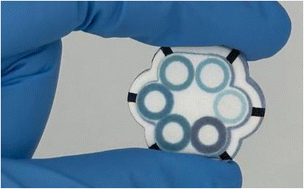All-electrical antibiotic susceptibility and resistance profiling of electrogenic Pseudomonas aeruginosa†
Abstract
There is a pressing need for evidence-based, non-surgical therapy guidance for biofilm-based infections. Conventional phenotypic or genotypic or emerging antibiotic susceptibility testing (AST) techniques cannot provide clinically relevant guidelines and widely adaptable stewardship for effective biofilm treatment because they are mainly limited to planktonic bacteria and suffer from many technical and operational challenges. Here, we created an all-electrical, reliable, rapid AST device to monitor antibiotic efficacy in bacterial biofilms that can be practically translatable to clinical settings and industrial antibiotic developments. The electrons metabolically produced by a Pseudomonas aeruginosa biofilm provided a strong signal for monitoring bacterial growth and treatment efficacy while a 3-D paper-based culturing platform provided a new strategy for rapid biofilm formation through capillary action. When antibiotics are effective against the pathogenic biofilm, their metabolic activities are inhibited, decreasing their electron transfer reactions. The changes in electrical outputs can be measured to assess the treatment effectiveness against pathogenic biofilms. Within 100 minutes, our six-well AST device successfully distinguished antibiotic-susceptible and -resistant P. aeruginosa biofilms, provided a quantifiable minimum inhibitory concentration (MIC) of antibiotics, and characterized the bacterial antibiotic action mechanisms.

- This article is part of the themed collection: Analyst HOT Articles 2023


 Please wait while we load your content...
Please wait while we load your content...